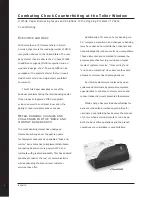
C
OUNTERFEIT CHECKS
COME FULL CIRCLE
Criminals adjusted to the installation of check
readers at the teller window by acquiring MICR
toner to make their counterfeit checks pass
through the check readers. Tracing the history of
counterfeits presented over the counter shows that
initially the MICR quality was poor, with perhaps
no more than half of the documents with sufficient
levels of magnetic ink to be considered “good”
checks. As criminals began to utilize MICR toner
to make their counterfeits, Ingenico’s analysis
indicated a steady rise in MICR quality.
Between late 1997 and into early 1999, it
appeared that the effectiveness of a MICR reader
for counterfeit detection via the MICR line had run
its course. However, beginning in mid-1999 and
into the present, MICR quality in counterfeit
checks has fallen. The number of bank’s deploying
check readers for assistance in detecting fraud
began to rise, mirroring the demand of the
mid-1990’s.
What caused this change? Ingenico analysis
on counterfeit documents, and interviews with
banks and law enforcement agencies indicated an
interesting trend. The “market” was being flooded
by new counterfeiters using relatively low cost
PC’s, scanners and laser printers. While the quality
of counterfeit checks produced by professional
criminals did not drop, the influx of new counter-
feiters caused an overall drop in MICR quality.
Due to media publicity and the availability
of “do-it-yourself” information on the Internet,
an entire new group of criminals was seizing
counterfeit check fraud as an opportunity for easy
money. As it was during the early to mid-nineties,
so it is today.
4.





















